
Should you Walk like a Penguin
for safety in the winter?
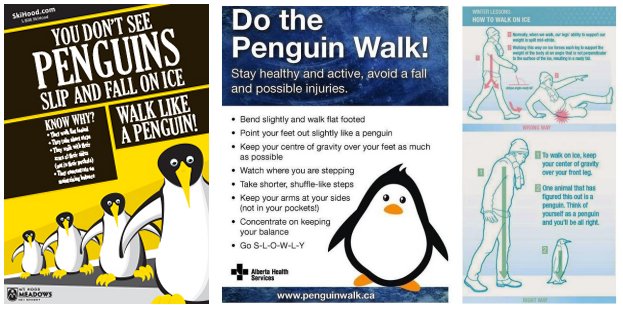
This meme is widespread, with mostly good suggestions:
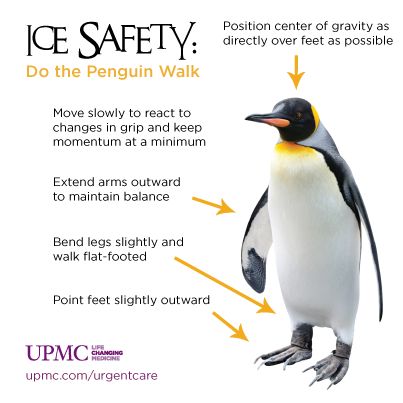
Footwear is also important: notice that penguins have natural spiked crampons on their feet!
You cannot walk in a normal manner and be safe on slippery ice. The "walk like a penguin," advice is useful in
that it makes you think more about how you are walking, resulting in slower,
more careful ambulation. But shuffling along with your head bent down and weight forward is not always a
good solution.
This very popular infographic is somewhat misleading in its analysis of the forces involved:

www.tabletinfographics.com/store/ice-safety-poster
The problem is not that your weight is split in mid-stride, it
is
that your forward momentum puts much more force in a forward horizontal
direction when the front foot strikes the ground. Normal walking
is quite efficient: on a flat path we recover about 65% of our energy
by planting the front foot and letting our momentum carry
us forward and over it. In a normal walking gait, every step
is actually a forward fall, caught by our front foot as shown below.
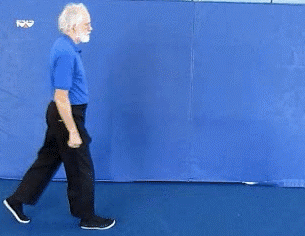
But, if there is no friction to hold
the front foot it shoots forward, and driven by momentum
and your weight pressing into the skidding leg, down you can go.
In the image below, a front mis-step and slip is simulated:
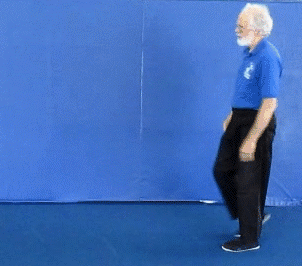
Ideally, you can use "Tai chi walking" to reduce the horizontal
slipping force to nearly zero. You balance on one leg while the
other reaches out "empty" with no weight. When the front foot
touches the ground you smoothly transfer your weight from the back leg
to the front leg: the force in the front foot is almost straight
down. When all your weight is on the front foot the empty back
foot is picked up and gently moved to the front, placed on the ground,
and the cycle repeats. This image below shows the slow and exaggerated
stepping movement from the Tai chi form. Although the step is
large, there is no forward push on the front foot, or rearward push-off
from the back foot.
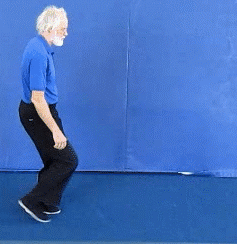
This may sound complicated but you did it all the time as a kid:
"walking tiptoe" we called it. Whether you touch with the toe or
the heel first the important thing is that there is hardly any weight
on the foot when it makes contact.
To walk more safely you must give up some
efficiency and speed: reduce your momentum by walking more slowly
and shorten your
stride length to shrink the horizontal force pushing forward on the
front foot. Step forward lightly and carefully.
Be sensible, pay attention, and shift into more of a "Tai chi walking" movement when crossing slippery or unsure areas.
But, don't drag your feet by shuffling, or bend your head over to look straight down.
Shuffling along with the feet close together and the center of gravity
(your weight) always forward is a recipe for a forward tripping fall.
This is true even for penguins! As a study by Dr. Astrid
Willener while at Roehampton University in London found:


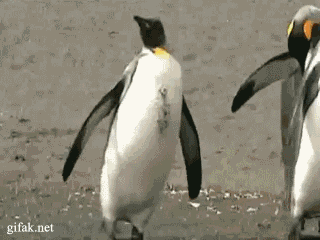
A fully-stuffed penguin walking in
from just feeding.
Lastly, remember that when penguins face a flat
and really slippery surface, they have other options!
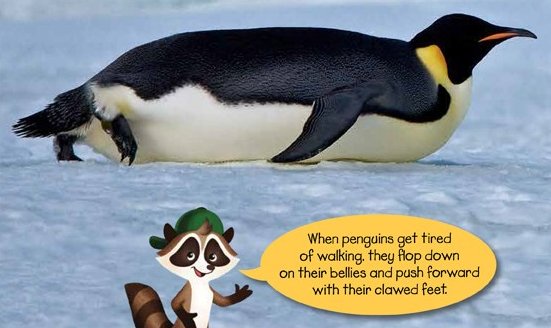
From Ranger Rick's nature magazine










